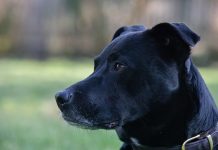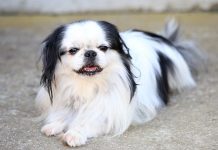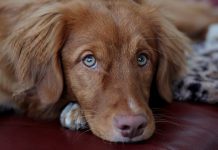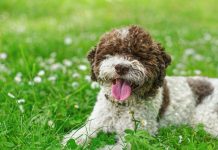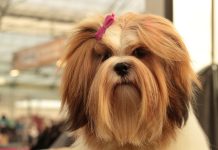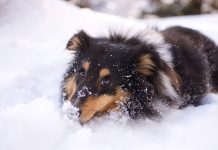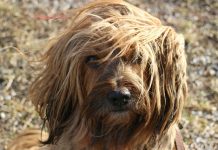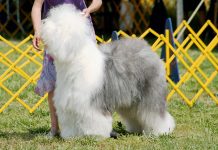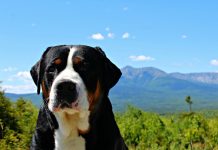History and Origins of the Flat-Coated Retriever Breed

The Flat-Coated Retriever is a distinctive breed known for its friendly disposition and intelligence. Its origins can be traced back to mid-19th century England, where it was developed as a versatile hunting companion capable of retrieving game on both land and water.
- Early Development: The breed is believed to have been developed from a combination of other retriever breeds such as the St. John’s Newfoundland, Labrador Retriever, Water Spaniel, and possibly Collie and Setter bloodlines. These crosses were carefully selected to produce a dog with exceptional retrieving abilities and a unique flat-lying coat.
- Origins of the Name: The breed’s name, “Flat-Coated Retriever,” directly references its defining feature—the sleek, flat coat that distinguishes it from other retriever breeds like the Labrador and Golden Retrievers.
- Popularity and Decline: Flat-Coated Retrievers gained popularity during the latter half of the 19th century in England and were favored by sportsmen for their efficiency in retrieving game. However, their numbers declined following World War I due to changes in hunting practices and preferences for other retriever breeds.
- Revival: Efforts to revive the breed were successful, and by the mid-20th century, Flat-Coated Retrievers experienced a resurgence in popularity both as hunting dogs and as family companions.
Physical Characteristics and Appearance of Flat-Coated Retrievers
Flat-Coated Retrievers are known for their elegant and streamlined appearance, coupled with a joyful and friendly demeanor.
- Size and Build:
- Size: Flat-Coated Retrievers are medium to large-sized dogs. Males typically stand between 23-24.5 inches (58-62 cm) at the shoulder, while females are slightly smaller at 22-23.5 inches (56-60 cm).
- Build: They have a strong, athletic build with a deep chest, level back, and well-muscled hindquarters, reflecting their origins as capable working retrievers.
- Coat:
- Distinctive Feature: The breed’s most distinctive feature is its dense, flat-lying coat, which is of medium length and water-resistant.
- Color: The coat is typically solid black or liver (reddish-brown), with no white markings. Occasionally, some individuals may have a small white spot on the chest.
- Head and Expression:
- Head: The head is proportionate to the body, with a moderate stop and a clean-cut, refined appearance.
- Eyes and Ears: They have dark brown eyes that convey a friendly expression and pendant ears that lie close to the head.
- Tail:
- Characteristic Tail: The breed is known for its distinctive “feathered” tail, which is carried straight or slightly curved and is an extension of the sleek coat.
- Gait:
- Energetic Movement: Flat-Coated Retrievers move with an effortless and energetic gait, covering ground efficiently with a fluid stride.
Overall, the Flat-Coated Retriever is a well-balanced and harmoniously built breed, combining grace with athleticism. Their friendly nature and keen intelligence make them excellent companions for active families and a joy to have both in the field and at home.
Flat-Coated Retriever Temperament and Personality Traits
Flat-Coated Retrievers are renowned for their outgoing and enthusiastic personalities. They are friendly, affectionate, and highly social dogs that thrive on companionship and interaction with their family members. Here are some key temperament and personality traits of the Flat-Coated Retriever:
- Friendly and Playful: Flat-Coated Retrievers are known for their friendly demeanor and love for play. They are typically good-natured with people, including children, and are often eager to make new friends.
- Energetic and Enthusiastic: This breed is highly energetic and requires regular exercise and mental stimulation. They retain their playful and puppy-like demeanor well into adulthood.
- Intelligent and Trainable: Flat-Coated Retrievers are intelligent dogs that respond well to positive training methods. They are eager to please their owners and excel in various dog sports and activities.
- Affectionate and Loyal: They form strong bonds with their families and are devoted companions. Flat-Coated Retrievers often seek out physical affection and enjoy being part of family activities.
- Social Butterflies: These dogs enjoy the company of both humans and other dogs. They may not thrive in isolation and prefer to be included in family gatherings and outings.
- Alert and Protective: While not typically aggressive, Flat-Coated Retrievers are naturally watchful and may bark to alert their owners of any unusual activity or visitors.
- Mischievous Streak: They have a playful and sometimes mischievous streak, which adds to their charm but also requires consistent training and supervision.
Training and Exercise Needs for Flat-Coated Retrievers
Flat-Coated Retrievers are active dogs that require both physical exercise and mental stimulation to thrive. They enjoy participating in various activities and excel in obedience training and dog sports.
- Regular Exercise: These dogs have high energy levels and require daily exercise to stay healthy and happy. Activities like brisk walks, jogging, hiking, and retrieving games are ideal for them.
- Engage in Mental Stimulation: Flat-Coated Retrievers are intelligent dogs that need mental challenges to prevent boredom. Puzzle toys, interactive games, and training sessions can keep their minds sharp.
- Positive Reinforcement Training: Use positive and reward-based training methods with Flat-Coated Retrievers. They respond well to praise, treats, and consistency in training.
- Start Early and Be Consistent: Begin training and socialization early in puppyhood to shape their behavior positively. Consistent rules and boundaries help them understand what is expected of them.
- Provide Social Interaction: Flat-Coated Retrievers thrive on social interaction. Regular opportunities to meet new people and other dogs can help them develop good social skills.
- Prevent Boredom: To prevent destructive behaviors, provide them with plenty of toys, activities, and companionship. Interactive playtime and regular exercise sessions are crucial.
- Be Patient and Persistent: While they are eager to learn, Flat-Coated Retrievers may have a playful and sometimes stubborn side. Patience, positive reinforcement, and consistency are key to successful training.
By meeting their exercise and training needs and providing ample love and attention, Flat-Coated Retrievers make excellent family pets and companions for active individuals who can provide them with the mental and physical stimulation they require.
Health Considerations and Common Issues in Flat-Coated Retrievers
While Flat-Coated Retrievers are generally healthy dogs, like all breeds, they are prone to certain genetic health conditions and issues. Responsible breeding practices and regular veterinary care are important to maintain their health and well-being. Common health considerations for Flat-Coated Retrievers include:
- Cancer: Flat-Coated Retrievers have a higher predisposition to certain cancers compared to other breeds. The most common types include histiocytic sarcoma, hemangiosarcoma, and osteosarcoma.
- Hip Dysplasia: This is a hereditary condition where the hip joint doesn’t develop properly, leading to arthritis and mobility issues. Regular screening and responsible breeding practices can help reduce the incidence of hip dysplasia.
- Elbow Dysplasia: Similar to hip dysplasia, elbow dysplasia is a developmental condition affecting the elbow joint, leading to lameness and arthritis.
- Progressive Retinal Atrophy (PRA): PRA is a genetic disease that causes progressive degeneration of the retina, leading to vision loss and eventual blindness.
- Patellar Luxation: This condition occurs when the kneecap (patella) slips out of place, causing pain and lameness.
- Cardiac Issues: Flat-Coated Retrievers can be prone to certain heart conditions such as dilated cardiomyopathy (DCM) and subvalvular aortic stenosis (SAS).
- Autoimmune Disorders: Some Flat-Coated Retrievers may develop autoimmune diseases such as autoimmune hemolytic anemia (AIHA) or immune-mediated thrombocytopenia (ITP).
Regular veterinary check-ups, genetic screening, and maintaining a healthy lifestyle are essential for managing these potential health concerns and ensuring the longevity and quality of life of Flat-Coated Retrievers.
Living with a Flat-Coated Retriever: Suitable Environments and Lifestyle Considerations
Flat-Coated Retrievers are active, social, and people-oriented dogs that thrive in environments where they can be part of the family and participate in various activities. Here are lifestyle considerations for living with a Flat-Coated Retriever:
- Space Requirements: Flat-Coated Retrievers are medium to large-sized dogs that benefit from having ample space to move around. They are adaptable to various living situations but do best in homes with access to a fenced yard or regular outdoor exercise areas.
- Exercise Needs: This breed requires regular exercise to stay healthy and prevent boredom. Plan for daily walks, playtime, and interactive activities such as retrieving games or agility training.
- Social Interaction: Flat-Coated Retrievers are highly social dogs that thrive on companionship. They enjoy being part of family activities and may become distressed if left alone for long periods. Ensure they have regular social interaction and avoid prolonged isolation.
- Training and Mental Stimulation: These intelligent dogs benefit from obedience training and mental challenges. Engage them in activities that stimulate their minds, such as training sessions, puzzle toys, or interactive games.
- Grooming: Flat-Coated Retrievers have a dense coat that requires regular brushing to prevent matting and remove loose hair. They shed moderately throughout the year, with heavier seasonal shedding.
- Health Care: Regular veterinary check-ups, vaccinations, and preventive care are essential for maintaining their health. Stay informed about breed-specific health concerns and discuss preventive measures with your veterinarian.
- Family Compatibility: Flat-Coated Retrievers are excellent family pets and get along well with children and other pets when properly socialized. Supervise interactions with young children due to their exuberant nature.
In summary, Flat-Coated Retrievers are loving, energetic, and intelligent companions that thrive in active households where they receive plenty of exercise, mental stimulation, and social interaction. Providing a structured routine, consistent training, and attentive care will ensure a fulfilling and harmonious life with a Flat-Coated Retriever.
Flat-Coated Retriever Variations and Breeding Practices

Flat-Coated Retrievers, while typically recognized for their black or liver-colored coats and specific breed standards, can exhibit variations in appearance and temperament. These variations may arise due to differences in breeding practices and the historical development of the breed. Here are some aspects to consider regarding Flat-Coated Retriever variations and breeding practices:
- Coat Color Variations:
- Black vs. Liver: The standard coat colors for Flat-Coated Retrievers are solid black or liver (reddish-brown). Occasionally, you may find variations in shade within these colors, but reputable breeders adhere to the breed standard in coloration.
- Size and Structure:
- Standardization: Flat-Coated Retrievers should generally fall within a specific size range and exhibit a balanced and athletic build. Deviations from the breed standard in terms of size or structure may indicate variations in breeding practices.
- Temperament and Behavior:
- Consistency in Traits: Reputable breeders strive to produce Flat-Coated Retrievers with consistent temperament traits, including friendliness, intelligence, and sociability. Variations in temperament could result from differences in breeding goals or practices.
- Health and Genetic Considerations:
- Health Testing: Responsible breeders conduct health screenings and genetic testing to reduce the risk of hereditary diseases and maintain the overall health of Flat-Coated Retrievers.
- Breeding Ethics: Ethical breeding practices prioritize the health and well-being of the dogs, aiming to preserve and improve the breed standard over generations.
- Breeding Goals:
- Performance vs. Conformation: Some breeders focus on producing Flat-Coated Retrievers with excellent hunting or performance abilities, while others prioritize conforming to breed standards for show purposes.
- Diversity and Preservation: Maintaining genetic diversity within the breed is crucial to avoid inbreeding and preserve desirable traits.
- Breed Clubs and Standards:
- Adherence to Standards: Flat-Coated Retriever breed clubs and kennel clubs establish and maintain breed standards to guide responsible breeding practices and ensure the integrity of the breed.
- Ethical Considerations:
- Responsible Breeding Practices: Ethical breeders prioritize the health, temperament, and overall welfare of the dogs they produce, adhering to guidelines set forth by breed clubs and kennel clubs.
- Avoiding Puppy Mills: Potential buyers should be cautious of purchasing Flat-Coated Retrievers from puppy mills or unscrupulous breeders who prioritize profit over the well-being of the dogs.
In summary, variations in Flat-Coated Retrievers can arise due to differences in breeding goals, practices, and adherence to breed standards. Responsible breeding practices, including health testing, adherence to breed standards, and prioritizing the welfare of the dogs, are essential for maintaining the integrity and quality of this beloved breed. Prospective owners should seek reputable breeders who demonstrate a commitment to ethical breeding practices and breed preservation.
Best Names with Meanings for Flat-Coated Retrievers
Naming a Flat-Coated Retriever can be a fun and meaningful process. Here are 50 name suggestions along with their meanings that could be suitable for this energetic and friendly breed:
Male Names:
- Apollo – Meaning “god of music, poetry, art, and oracles” in Greek mythology.
- Hunter – Reflecting the breed’s hunting heritage.
- Ace – Signifying excellence or superiority.
- Finn – Meaning “fair” or “white” in Gaelic.
- Baxter – Referring to a “baker” in Old English.
- Cosmo – Derived from the Greek word for “order” or “decoration.”
- Hudson – Referring to the English surname meaning “son of Hudde” (a medieval given name).
- Oakley – Inspired by the oak tree, symbolizing strength and endurance.
- Ranger – Suitable for a dog known for its outdoor and adventurous spirit.
- Sawyer – Referring to a “woodcutter” or “woodworker.”
- Wyatt – Meaning “brave in war” or “hardy” in Old English.
Female Names:
- Luna – Latin for “moon,” symbolizing brightness and beauty.
- Willow – Inspired by the graceful and resilient willow tree.
- Bella – Meaning “beautiful” in Italian.
- Scout – Perfect for a dog that loves exploring and scouting.
- Sadie – Derived from “Sarah,” meaning “princess” in Hebrew.
- Juniper – Named after the aromatic evergreen shrub.
- Harper – Referring to someone who plays the harp, symbolizing elegance.
- Zara – Arabic for “princess” or “flower.”
- Maggie – Short for Margaret, meaning “pearl.”
- Stella – Latin for “star,” symbolizing brightness and radiance.
- Ruby – Inspired by the precious gemstone known for its deep red color.
Unisex Names:
- Copper – Reflecting the breed’s reddish-brown coat color.
- Sunny – Signifying joy and happiness.
- River – Inspired by the flowing water, representing strength and adaptability.
- Piper – Referring to someone who plays the pipes, symbolizing musicality.
- Bailey – Meaning “bailiff” or “law enforcer” in Old English.
- Charlie – A friendly and popular name suitable for both males and females.
- Milo – Derived from the Old Slavic word for “merciful” or “gracious.”
- Skye – Named after the beautiful Isle of Skye in Scotland.
- Cody – Meaning “helpful” or “pillow” in Gaelic.
- Riley – Signifying courage and resilience.
Nature-Inspired Names:
- Aspen – Named after the tall, graceful aspen tree.
- Brook – Referring to a small, flowing stream.
- Fern – Inspired by the delicate and lush fern plant.
- Olive – Named after the olive tree, symbolizing peace and wisdom.
- Storm – Reflecting strength and power, like a powerful storm.
- Meadow – Signifying a lush and open grassy field.
- Echo – Inspired by the echo of sound in nature.
- Canyon – Symbolizing depth and grandeur, like a majestic canyon.
- Willow – Named after the graceful willow tree, symbolizing resilience.
- Sage – Inspired by the aromatic and wise sage plant.
Mythology-Inspired Names:
- Atlas – Named after the Titan god who held up the celestial spheres in Greek mythology.
- Athena – Inspired by the Greek goddess of wisdom and warfare.
- Odin – Named after the Norse god of wisdom, poetry, and war.
- Freya – Inspired by the Norse goddess of love, beauty, and fertility.
- Apollo – Named after the Greek god of music, poetry, art, and prophecy.
Choose a name that resonates with your Flat-Coated Retriever’s personality, appearance, and the meaning you wish to convey. Whether you prefer a name inspired by nature, mythology, or a classic moniker, the perfect name will reflect your dog’s unique qualities and make a lasting impression.

In conclusion, this comprehensive guide to Flat-Coated Retriever dogs has provided a detailed overview of this versatile and energetic breed. Throughout our exploration, we’ve delved into the history, distinctive characteristics, and essential care considerations that define Flat-Coated Retrievers. Known for their friendly demeanor, intelligence, and athleticism, Flat-Coated Retrievers make excellent companions for active families and individuals. They excel in various activities, including retrieving, agility, and obedience, showcasing their versatility and eagerness to please. As you embark on your journey with a Flat-Coated Retriever, may you appreciate their unique qualities and form a strong bond with this delightful breed, creating lasting companionship and joy together.







